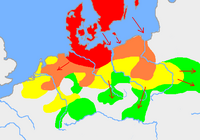| 东日耳曼语支 | |
|---|---|
| 地理分布 | 根据不同的时期而不同。现该语支已经全部灭绝 4世纪晚期:[1] 中欧及东欧(以及克里米亚) 4世纪晚期至10世纪早期[2] 南欧、西欧、东南欧及东欧的大部(包括克里米亚)和北非 10世纪早期至18世纪晚期[3] 只是局限在东欧(至远达克里米亚) |
| 谱系学分类 | 印欧语系
|
| 分支 | |
| ISO 639-5 | gme |
| – | |
| Glottolog | east2805[4] |
 | |

公元前750年的分布
公元前500年的分布
公元前250年的分布
公元1世纪的分布
东日耳曼语支是印欧语系日耳曼语族之下一个已经灭绝的语支,唯一已知文字的东日耳曼语支语言是哥德语。其他被认定同是东日耳曼语支的语言有汪达尔语、勃艮第日耳曼语、伦巴底日耳曼语和克里米亚哥德语。克里米亚哥德语使用者相信在18世纪之前它仍然被使用。现时,我们一般只能从带有东日耳曼语痕迹的地名来了解这种语言在当年的流通范围。
历史


直至公元1世纪,老普林尼、塔西佗等人的记载都指出,当时欧洲存在着大量拥有共同祖先和文化的日耳曼人分支。
根据约达尼斯、普罗科匹厄斯等人的记载,以及一系列语言学、地名学及考古学发现,此前有结论称,当时的东日耳曼人从斯堪的纳维亚本岛迁徙至易北河东岸。[5]而实际上,公元前14世纪至公元前12世纪期间(北欧青铜时期第三期),斯堪的纳维亚对波美拉尼亚及今天波兰北部的影响力相当大,乃至该地区有时会被纳为北欧青铜时期的文化影响范围内。 (Dabrowski 1989:73)
而考古学及地名学方面的发现亦指出,勃艮第人生活在丹麦的博恩霍尔姆岛上,而鲁基人则生活在挪威海岸罗加兰郡。
过去曾有假说认为哥特语及北日耳曼语支语言应组为同一语支,但该假说在学术界已经过时:东日耳曼语现已普遍被认为是一个独立的日耳曼语分支,并且以中欧北部(尤其是现今的波兰)为东支部落的故土。同时,亦有认为,该语支最有可能是最终从原始日耳曼语分化出的分支(大概在公元前11世纪左右)。
分支
备注
- ↑ From origins until the beginning of the Migration Period.
- ↑ From the onset of the Migration Period until extinctions of major East Germanic languages with the last one occurring in the early 10th century.
- ↑ From the last major extinction until the 18th century demise of Crimean Gothic.
- ↑ Hammarström, Harald; Forkel, Robert; Haspelmath, Martin; Bank, Sebastian (编). 東日耳曼語支. Glottolog 2.7. Jena: Max Planck Institute for the Science of Human History. 2016.
- ↑ The Penguin Atlas of World History, Hermann Kinder and Werner Hilgemann; translated by Ernest A. Menze; with maps designed by Harald and Ruth Bukor. Harmondsworth: Penguin Books. ISBN 0-14-051054-0, 1988. Volume 1, p. 109.
参考文献
- Dabrowski, J. (1989) Nordische Kreis und Kulturen Polnischer Gebiete. Die Bronzezeit im Ostseegebiet. Ein Rapport der Kgl. Schwedischen Akademie der Literatur, Geschichte und Altertumsforschung über das Julita-Symposium 1986. Ed Ambrosiani, Björn Kungl. Vitterhets Historie och Antikvitets Akademien. Konferenser 22. Stockholm. ISBN 91-7402-203-2
- Demougeot, E. La formation de l'Europe et les invasions barbares, Paris: Editions Montaigne, 1969–74.
- Kaliff, Anders. 2001. Gothic Connections. Contacts between eastern Scandinavia and the southern Baltic coast 1000 BCE – 500 CE.
- Musset, L. Les invasions: les vagues germanique, Paris: Presses universitaires de France, 1965.
- Nordgren, I. 2004. Well Spring of The Goths. About the Gothic Peoples in the Nordic Countries and on the Continent.
参见
日耳曼语族历史
| 前罗马铁器时代 前500年–前100年 |
罗马铁器时代早期 前100年–100年 |
罗马铁器时代晚期 100年–300年 |
迁徙时期 300年–600年 |
中世纪前期 600年–1100年 |
中世纪 1100–1350年 |
中世纪后期 1350年–1500年 |
近代早期 1500年–1700年 |
现代 1700年至今 | |
| 原始日耳曼语 | 西日耳曼语 | 厄尔米诺内语 (易北河日耳曼语) |
原始高地德语 | 古高地德语、 伦巴底语 |
中古高地德语 | 早期现代高地德语 | 高地德语各变种 | ||
| 标准德语 | |||||||||
| 伊斯特沃内语 (威悉-莱茵日耳曼语) |
原始法兰克语 | 古法兰克语 | 古中部德语 | 中古中部德语 | 早期现代中部德语 | ||||
| 中部德语各变种 | |||||||||
| 古低地法兰克语 (古荷兰语) |
早期林堡语 中古荷兰语 |
晚期林堡语 中古荷兰语 |
早期林堡语 | 林堡语 | |||||
| 早期 中古荷兰语 |
晚期 中古荷兰语 |
早期 现代荷兰语 |
荷兰语各变种 | ||||||
| 南非语 | |||||||||
| 因格沃内语 (北海日耳曼语) |
原始撒克逊语 (东南因格沃内语) |
古撒克逊语 | 中古低地德语 | 低地德语各变种 | |||||
| 盎格鲁-弗里西语 (西北因格沃内语) |
原始弗里西语 | 古弗里西语 | 中古弗里西语 | 弗里西语各变种 | |||||
| 原始英语 | 古英语 (盎格鲁-撒克逊) |
早期 中古英语 |
晚期 中古英语 |
近代英语 | 英语各变种 | ||||
| 早期苏格兰语 | 中古苏格兰语 | 苏格兰语各变种 | |||||||
| 北日耳曼语 | 原始诺尔斯语 | 卢恩 古西诺尔斯语 |
古冰岛语 | 晚期 古冰岛语 |
冰岛语 | ||||
| 古挪威语 | 古法罗语 | 法罗语 | |||||||
| 古诺恩语 | 诺恩语 | 灭绝 | |||||||
| 卢恩 古东诺尔斯语 |
中古挪威语 | 挪威语 | |||||||
| 早期 古丹麦语 |
晚期 古丹麦语 |
丹麦语 | |||||||
| 早期 古瑞典语 |
晚期 古瑞典语 |
瑞典语 | |||||||
| 达拉纳方言 | |||||||||
| 卢恩 古哥得兰语 |
早期 古哥得兰语 |
晚期 古哥得兰语 |
哥得兰语 | ||||||
| 东日耳曼语 | 哥特语 | (未证实哥特语方言) | 克里米亚哥特语 | 灭绝 | |||||
| 汪达尔语 | 灭绝 | ||||||||
| 勃艮第语 | 灭绝 | ||||||||
- 注解
- ^1 伦巴底语的谱系学界分类存在争议。其亦被归类为同古撒克逊语相近。
- ^2 中世纪后期指黑死病时期之后。黑死病对当时挪威语言状况的影响尤甚。
- ^3 自早期北部中古英语产生[1]。麦克鲁尔认为应为诺森布里亚古英语[2]。《牛津简明英语语言词典》(第894页)中称苏格兰语的“来源”为“伯尼西亚王国的古英语”和“12至13世纪来自北英格兰和英格兰中部移民受到斯堪的纳维亚影响的英语”。“早期-中古-现代苏格兰语”的阶段划分在《简明苏格兰语词典》[3]及《古苏格兰语辞典》[4]中得到使用。
- ^4 诺恩语的使用者为现代苏格兰语所同化(海岛苏格兰语)。
- ^5 现代哥得兰语(Gutamål)为古哥得兰语(Gutniska)的直系继承,现已成为标准瑞典语的哥得兰岛方言(Gotländska)。
- ^6 大陆古挪威语为介于古西诺尔斯语和古东诺尔斯语之间的方言。
- ↑ Aitken, A. J. and McArthur, T. Eds. (1979) Languages of Scotland. Edinburgh,Chambers. p. 87
- ↑ McClure (1991) in The Cambridge History of the English Language Vol. 5. p. 23.
- ↑ Robinson M. (ed.) (1985) the "Concise Scots Dictionary, Chambers, Edinburgh. p. xiii
- ↑ Dareau M., Pike l. and Watson, H (eds) (2002) "A Dictionary of the Older Scottish Tongue" Vol. XII, Oxford University Press. p. xxxiv